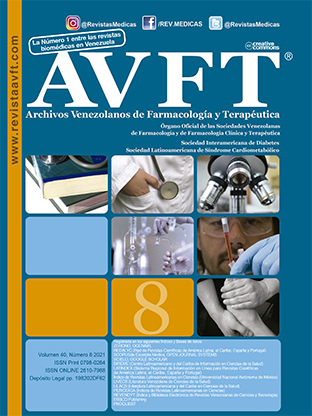Orbital Hydatid Cyst: assessment of age, gender, site distribution and clinical presentation
Keywords:
Orbital Hydatid Cyst, age, gender, site distribution, clinical presentationAbstract
Background: Any luminal closed space that is lined by either membranous or cellular sheathe and containing air, fluid, solid or semisolid material is called Cyst. In the Orbit this cyst can be resulted from either ductal obstruction, developmental, or parasitic infestation, Objective: Assessment of the distribution of Orbital Hydatid cyst according to age, gender, site, clinical features. Method: A retrospective study conducted for the period from 2010-2020, during which 632 patients with orbital cyst attend the Orbital clinic in Medical city in Baghdad. This clinic receives most of orbital cases from all governorate of Iraq. Results: Ten patients out of 632 cases had Orbital Hydatid cyst (1.58%). The age was ranging from 3-15 years with a mean of (8.6±4.1 years). Three cases were female, with a male to female ratio 2:1. Orbital Hydatid cyst affecting the right side in 6 patients, while the left orbit was involved in 4 patients. No bilateral Orbital Hydatid cyst. With respect to the site of the lesion inside the orbit, 3 of them were superiomedial, while seven were superiolateral, no inferior lesion found in this study. The most common presenting features was painless proptosis (90%), followed by chemosis (60%), and conjunctival edema 30%. Conclusion: Hydatid disease of the Orbit usually it is the primary lesion, which is rare disease. Most of the cases are unilateral, located superiorly (medial or lateral) retro bulbar in location whether extra or intraconal. No sex dominance found although commonly affect children and teens. The most common clinical presentation is painless proptosis. When suspected, patients better to be evaluated by either computed tomography or by magnetic resonance imaging.
Downloads
References
lawrence M, Kuafman MD,ph.D, J Pablo Villablanca, MD. Mahmood F. Mafee, MD, FACR; Diagnostic imaging of cystic lesions in the child’s Orbit. Full length Article, Nov. (1) 1998, Vol. 36, Issue 6, P 1149-1163.
Kahveci R, Sanli AM, Gürer B, Sekerci Z. Orbital hydatid cyst. J Neurosurg Pediatr. 2012 Jan;9(1):42-4.
Hayder A. Alhemiarya;Orbital Hydatid Disease: A case study of young patients with primary orbital lesion.Al-Kindy College Medical Journal 2014, Volume 10, Issue 1, Pages 52-55
Header D. Al-Muala, Suha M. Sami, Mahamoud A. R. Shukri, Header K. Hasson, and Abbas T. Alaboudy; Orbital hydatid cyst. Ann Maxillofac Surg. 2012 Jul-Dec; 2(2): 197–199.
Salma Benazzou MD, Said Derraz MD, Orbital hydatid cyst: Review of 10 cases Journal of Cranio-Maxillofacial Surgery, Volume 38, Issue 4, June 2010, Pages 274-278.
Adolfo Gomez Morales, MD, J Oscar Croxatto, MD, Louis Crovetto, MD: Hydatid cyst of the Orbit, A review of 35 cases. Full length Article, Aug. (1) 1988, Vol. 95, Issue 8, P 1027-1032.
Pelin Seher Öztekin, MD, Behice Kaniye Yilmaz, MD, Fatma Dilek Gokharman, MD, and Pınar Nergis Koşar, MD; Primary orbital hydatid cyst: computed tomography and magnetic resonance imaging findings. Singapore Med J. 2014 Nov; 55(11): e184–e186.
Cooney RM, Flanagan KP, Zehyle E. Review of surgical management of cystic hydatid disease in a resourse limited setting: Turkana, Kenya. Eur J Gastroenterol Hepatol. 2004; 16:1233–6. [PubMed] [Google Scholar]
Gomez Morales A, Craxatto JO, Cravetto L, Ebner R. Hydatid cyst of the orbit. A review of 35 cases. Ophthalmology. 1998; 95:1027–32.
Talib H.; Orbital hydatid disease. Iraq.Br J surg. 1972; 59:391-94.
Hayder K. Hassoun, Hayder D. Al-Mualla, Mahmmoud Al-Shukri; Can Orbital Hydatid Cyst Presents With Acute Visual Loss? Case Report and Literature Review. Iraqi Academic Scientific Journal,2013, Volume 12, Issue 3, Pages 466-469.
Downloads
Published
How to Cite
Issue
Section
License
Copyright (c) 2023 AVFT – Archivos Venezolanos de Farmacología y Terapéutica

This work is licensed under a Creative Commons Attribution-NonCommercial-NoDerivatives 4.0 International License.




